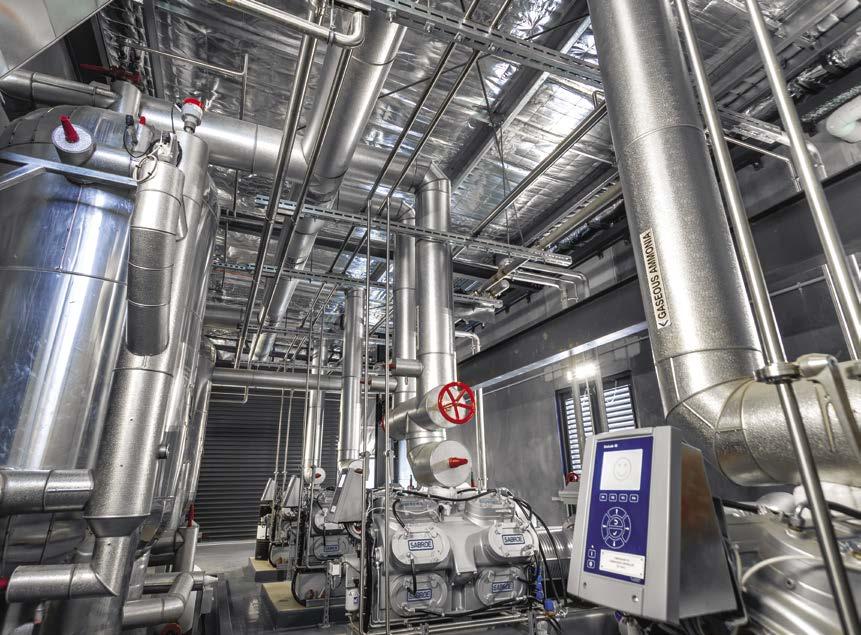
10 minute read
FLUID THINKING
Ammonia is a naturally occurring compound found in the environment. A key element in the nitrogen cycle, it is essential for many biological processes and is therefore found in water, soil and the air. In fact, it is one of the most abundant gases on the planet. Made up of one nitrogen atom and three hydrogen atoms, ammonia is described by the chemical symbol NH3. In refrigeration parlance, it is also known as R717. According to the International Institute of Ammonia Refrigeration (IIAR), it was first used as a refrigerant in the 1850s in France before being used to produce ice in the USA the following decade.
By the early 1900s, ammonia refrigeration machines were widely in use for block ice, food processing and chemical production facilities. This led to ammonia becoming the backbone of the cold storage and food processing industries, with the first commercial production of synthetic ammonia occurring in 1913.
Advertisement
Over a century on, global production of ammonia topped 236 million tonnes in 2021.
“Presently, there are an estimated two billion metric tons of ammonia in the world (and) of this amount, approximately 5 per cent is man made,” says the IIAR.
Less than 2 per cent of the world’s ammonia is used for refrigeration. As well as the huge quantities of ammonia that are used in agriculture as fertiliser, it is also a building block in pharmaceutical products and in the manufacture of plastics, explosives, textiles, pesticides, dyes and other chemicals.
As one of only two fuels that combust without the formation of carbon dioxide (CO2), ammonia’s use as a fuel is also the subject of much research and development around the world, including here in Australia.
Zero Hero
As far as refrigerants go, ammonia ticks many boxes. It is a substance with zero ODP (ozone depletion potential) and zero GWP (global warming potential) – giving it an advantage over HFC (hydrofluorocarbons) and the HFO (hydrofluoroolefin) refrigerants and blends used as we transition away from synthetic refrigerants.
Ammonia also possesses highly favourable thermodynamic and transport properties.
“Ammonia is the refrigerant of choice in almost all large scale industrial refrigeration and freezing applications,” says Stefan Jensen, F.AIRAH, Managing Director of Scantec Refrigeration Technologies. Its latent heat of vaporisation is several times that of other commonly used refrigerants including other natural refrigerants like CO2 and propane, with very little required to perform the same amount of cooling. Despite these advantages, Jensen says a significant challenge for practitioners designing ammonia refrigerating plant lies in making ammonia the best it can be.
“Put differently, the challenge is to maximise the inherent advantages of ammonia refrigerant through the refrigeration system design,” he says.
Historically, liquid overfeed systems have been widely associated with the use of ammonia as a refrigerant since the concept was patented by the York Corporation in 1925. Almost a century on, it remains the most popular approach in large‑scale ammonia refrigerating plant.
In liquid overfeed ammonia refrigerating plant, the suction line network contains large amounts of liquefied ammonia. The operating principle of these systems is that the evaporator(s) is supplied
Nh3 Knowledge
with significantly more liquefied refrigerant than is vaporised. The term “overfeed rate” refers to the ratio between the quantity of liquefied refrigerant supplied versus the generally smaller quantity vaporised on a mass basis.
But recently, evidence is emerging from practical installations that the presence of large amounts of liquefied ammonia in the suction line network of some types of large, expansive liquid overfeed refrigerating systems in fact jeopardises energy efficiency much more than previously thought.
“A common plant type comprises ceiling suspended evaporators (air coolers), refrigerant pipelines in the ceiling cavity and a plant room at ground floor level,” says Jensen. “In these types of plant, specific energy consumption differences of approximately 30 per cent have been recorded.”
This margin, he says, represents the difference between the presence of liquefied refrigerant in the suction line network versus a network conveying saturated vapour only.
Consequently, decades long ammonia refrigeration plant design practices are now being challenged. These include ammonia inventories, part load energy performance, overfeed rate control, plant oversizing and resilience, maintenance costs, technical life, the design of small and medium‑size plant, control and monitoring.
“Some deeply entrenched myths pertaining to the suitability or otherwise of ammonia refrigerant in certain applications are also being challenged,” says Jensen.
This has led to the application of ammonia in medium and large scale air conditioning plant, supermarket systems, aquatic centres and small‑to‑medium foodservice facilities.
“A decade ago, these were almost exclusively serviced by air cooled HFC based refrigerating plant with electric defrost,” says Jensen. “Major refrigerated distribution centres that were serviced by R22 based liquid overfeed systems 15 years ago and consumed around 100kWh/m³ per year now routinely record specific energy consumption values that are around 10 times lower when serviced by centralised, low‑charge NH3 refrigerating plant.”
Andrew Pang, AM.AIRAH, Director of Andrew Pang and Associates, says that as well as keeping up to date with the latest advances in ammonia refrigeration technologies, professionals in the commercial and air conditioning sectors of our industry should consider brushing up on ammonia safety.
AIRAH offers a number of training courses specifically related to ammonia refrigeration.
Industrial Ammonia Plant Operations (3 days)
A popular and much sought after course both in Australia and New Zealand, this covers how various ammonia refrigeration plants work, their components and controls, maintenance, basic troubleshooting, legislative requirements, and ammonia safety. Suitable for ammonia plant operators, electricians, fitters, refrigeration mechanics and maintenance contractors, planners, supervisors and managers/engineers.
Ammonia Safety Awareness (half-day)
This course covers the understanding of ammonia properties, first aid requirements, ammonia safety equipment, basics of ammonia emergency site procedures, and preventative maintenance requirements for ammonia plants. Suitable for OH&S and emergency services personnel, mechanical services/air conditioning and commercial refrigeration professionals, refrigeration equipment manufacturers and suppliers, store personnel and anyone working in and around ammonia plants.
Ammonia Emergency Response (1 day)
This course provides participants with the skills to competently manage an onsite ammonia leak. It covers ammonia properties, first aid requirements, personal protection equipment, legislative framework including relevant safety standards and dangerous goods state codes, ammonia vapour and cloud dispersal, methods of control for vapour and liquid leaks, detailed ammonia emergency planning and preventative maintenance requirements. Suitable for ammonia plant operators and managers, refrigeration mechanics, and OH&S managers.
For more information and enrolment details, visit www.airah.org.au/education
Safety Notes
Although ammonia is highly toxic – reflected in its refrigerant classification B2L where “B” refers to toxicity and “2L” refers to its flammability class –well developed and highly mature safety standards for ammonia have been developed globally by organisations like the IIAR.
But unlike other class 2L (lower flammability) refrigerants, ammonia gives off a pungent odour that can be detected by humans at concentrations as low as 0.6 parts per million (ppm). A concentration around five hundred times higher than that is required to reach the IDLH (Immediately Dangerous to Life or Health) value of 300ppm.
“Ammonia is very often highlighted as a toxic and explosive substance,” says Andrew Pang AM.AIRAH, Director of Andrew Pang and Associates.
A consultant in the HVAC&R field for more than 20 years and a former RMIT University lecturer, Pang presents a number of refrigeration and air conditioning courses for AIRAH including the Ammonia Awareness and Emergency Response course.
“Ammonia is flammable, but it is not explosive. It burns with low energy and its flame propagation is low –7.2cm/s compared to 45cm/s for propane and 317cm/s for hydrogen. A very high temperature of 651˚C is also required to ignite ammonia, and 680mJ of ignition energy compared with 0.26mJ for propane and 0.02mJ for hydrogen.”
He says for ammonia to be flammable, its concentration needs to reach as high as 167,000ppm.
“This value being the lower flammability limit,” he says, “while the upper flammability limit is 340,000ppm. These values are well above detectable levels.”

Attention To Detail
An ammonia refrigeration plant differs from those designed for other refrigerants in almost every aspect, with these differences driven by two main factors: material compatibility and refrigerant toxicity.
Other factors to also be considered in the plant design are the demands of the ammonia plant user, the safety standards applicable both mechanically and electrically, the thermodynamic properties of ammonia, ammonia/oil miscibility, and ammonia surface tension.
“The ammonia plant is almost always more industrial in every respect than systems designed for other natural and synthetic working fluids,” says Jensen.
“This translates into a service life that is often two or more times longer than HFC, HFO or CO2 based systems. In the ammonia refrigeration industry, there is also a greater tendency towards repairs and overhauls as opposed to simple parts and plant replacement. This fits the modern sustainability agenda.”
Although the basic principles of ammonia refrigeration are similar to other refrigerants, there are some stark differences.
For instance, ammonia corrodes copper, zinc and their alloys very quickly. These metals are therefore not used in the piping and refrigeration components of ammonia refrigeration systems.
Ammonia can also absorb a small amount of water without the detrimental effect of ice formation at the orifice of the expansion valve, which can block refrigerant flow into the evaporator. Because of this, a desiccant drier is not installed in the liquid line of an ammonia system.
“Instead, an in line strainer is installed prior to the expansion valve,” Pang says.
Pang also notes that ammonia and the commonly used compressor lubricating oils are not miscible. Hence, an oil separator is installed after the compressor discharge to remove a very large percentage of the oil.
“Some oil will still get through the oil separator and into the rest of the system,” he says. “It usually ends up in the low side of the system with the oil at the bottom of the accumulator (liquid/vapour separator) as oil is denser than liquid ammonia.”
Oil should be periodically drained from the accumulator.


Going Low
Prior to the development of low charge DX systems, the evaporators used in ammonia refrigeration plant were usually of the flooded design type and either gravity fed or liquid overfeed.
Scantec Refrigeration Technologies has pioneered the use of low charge ammonia systems in Australia. This journey began when the individuals who later founded the company installed a DX NH3 system at Tingalpa in Brisbane in the early 1990s.
“Many lessons were learnt, some hard, but the plant remains operational today,” says Jensen.
The Tingalpa plant was followed by a central, dual‑stage DX NH3 system with screw compressors that has served a 10,000m2 distribution centre in Brisbane since 2003.
Both these ammonia refrigeration plants were fitted with evaporators manufactured from carbon steel and hot dipped galvanised after manufacture, while injection control was superheat based.
Another installation fitted with a low temperature evaporator manufactured from a less conductive material than carbon steel performed poorly – another hard lesson.
Following demands for a guaranteed maximum temperature differential across the evaporators between refrigerant and air, Scantec developed a centralised, low charge NH3 refrigerating plant design. Thirty of these now operate around Australia, as well as in China and Malaysia.
“One of these is a high rise with a refrigerated volume of approximately 125,000m³ and a specific energy consumption of 8.5kWh/m³ per year, beating the guaranteed value of 15kWh/m³ per year by a considerable margin,” Jensen says.
Expanded Horizons
Ammonia has become the go to working fluid for industrial refrigeration applications, and many believe it can and will penetrate other sectors that have previously been the domain of HFC and HFO blended refrigerants.
These include large scale air conditioning systems employing reticulated chilled water as a secondary refrigerant, and small to medium foodservice facilities with a refrigerated volume range of 5,000–30,000m³.
“There is no reason, with its refrigeration applications covered by mature and well developed technical and safety standards, why ammonia cannot be used as a primary refrigerant for water chilling and/or heating for air conditioning application in buildings,” says Pang.
Ammonia based packaged liquid chillers were shown to be successful in a retrofit of an existing air conditioning system servicing the administration building of the Logan City Council south of Brisbane. Similarly, ammonia based chillers have provided air conditioning to London Heathrow Airport’s Terminal 5 for many years, as well as at the Zürich Airport in Switzerland.
The Danish government has almost completed 20 medium to large scale heat pump installations using ammonia to serve district heating systems in local communities. Even the International Space Station (ISS) uses liquid ammonia through an external coolant loop in the station’s main shell to transport heat and keep equipment cool.
“In the US and Europe, ammonia and other natural refrigerants have been shown to be the best and most viable alternatives to meet the objectives of global agreements as well as more local regulations such as F Gas in Europe, and US EPA programs like SNAP and the AIM Act,” says IIAR International Director, Yesenia R Rector.
“Particularly in Europe, countries like Germany, Sweden, Norway, the Netherlands and Denmark are exploring ways to limit the use of PFAS (perfluoroalkyl and polyfluoroalkyl substances) chemicals, which will affect the use of HFOs and some HFCs as these degrade into harmful substances.”
For Australia to follow suit, Jensen believes investment in research and development needs to increase significantly, while training at all levels – from vocational to tertiary – must improve dramatically to advance the local skill set.
Despite this, there is evidence to suggest that Australian practitioners are leading the way in some ammonia refrigeration technologies.
“In miscellaneous narrow fields of application for ammonia refrigerant, it is fair to say that Australia has made world leading progress,” Jensen says. “But these advances have been made within the contracting fraternity more so than within academia – and it’s fair to say they have also been achieved completely without government facilitation of any kind.”
So far as the adoption of ammonia in air conditioning is concerned, Jensen says there is no doubt the local industry can do better.
“Ammonia has a very bright future in applications outside the industrial refrigeration sector, but the challenge for industrial refrigeration practitioners is to have the capacity to assist the progress of ammonia within these sectors using the expertise and experience earned within core refrigeration applications.”
Over to you, readers. ■
Proven Concept
Among a number of centralised, low charge NH3 systems to be installed by Scantec, three stand out for the significant energy savings they have delivered.
Replacement of an existing R404A based, air cooled plant with a two stage NH3 DX system delivering a reduction in specific energy consumption (SEC) from 206kWh/m³ to 72kWh/m³ per year (refrigerated volume overall 5,250m³).
Replacement of a screw compressor based NH3 plant with gravity flood refrigerant feed with a dual stage DX NH3 plant with reciprocating compressors delivering a reduction in SEC from 106kWh/m³ to 45kWh/m³ per year (overall refrigerated volume 10,000m³)
A 248,000m³ new refrigerated distribution centre with blast freezing serviced by the largest NH3 DX system designed and constructed to date – the plant was commissioned in the middle of 2022 and featured in Ecolibrium, Summer 2021. ■














